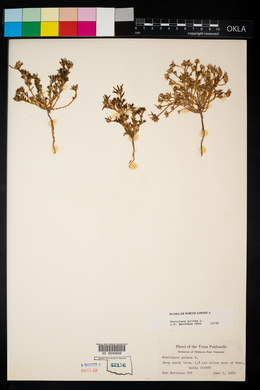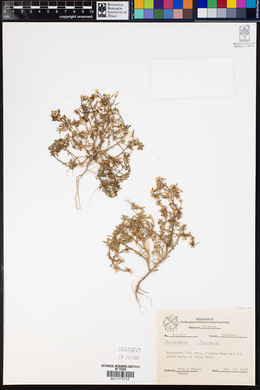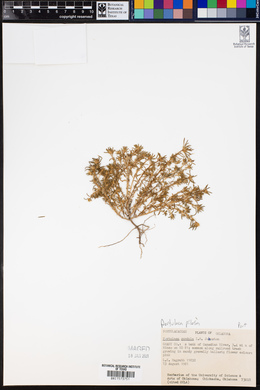|
|
|
|
Family: Portulacaceae
[Portulaca cyanosperma Egler, morePortulaca mundula I.M. Johnst.] |
Plants annual; roots fibrous to slightly fleshy. Stems prostrate, suberect to erect, succulent; trichomes conspicuous at nodes and in inflorescence; branches 3-25 cm. Leaf blades linear to oblong-lanceolate, terete to hemispheric, 5-20 × 1-3 mm, apex acute; involucrelike leaves 6-9. Flowers 5-12 mm diam.; petals dark pink to purple, obovate, 3-5(-7) × 1.5-3 mm; stamens 5-12(-37); stigmas 3-5(-6). Capsules ovoid, 1.5-4.3 mm diam. Seeds black or leaden, orbiculate (0.4-)0.5-0.6 mm diam.; surface cells loosely arranged, short-tuberculate and stellate to rounded-stellate; tubercles long or absent. 2n = 8, 16. Flowering late spring-early fall, year-round in s Fla. Dry soils, beaches, disturbed habitats, roadsides and railroads on limestone, granitic, and sandstone outcrops; 0-2000 m; Ala., Ariz., Ark., Fla., Ga., Kans., La., Miss., Mo., N.Mex., N.C., Okla., S.C., Tenn., Tex.; Mexico; West Indies; Central America; South America. Portulaca pilosa is a highly variable species. It exhibits morphologic variability during development, with immature plants having wider (to 4 mm), longer, and flatter leaves than mature specimens. Mature leaves are narrower, shorter, and hemispheric or terete in cross section. The Linnaean drawing of the type specimen may be an immature plant. Morphologic variability also occurs in relation to habitat differences over the large geographic range of this species. Plants growing in dry habitats have the greatest density of hairs; plants growing in moist habitats are less pilose. Plants with very dense hairs on old growth will, under more moist conditions, produce new growth with fewer hairs. Growth habit is also affected by habitat. Plants growing in warm, moist environments tend to branch quickly into a spreading habit, with erect growth following secondarily. Plants in cool, dry habitats grow erect first, then branch more slowly; the plant then has a compact habit. Specimens from Alabama, Arizona, Florida, Louisiana, Mississippi, New Mexico, and Texas exhibit all morphologic conditions. Those from Arkansas, Kansas, Missouri, and Oklahoma usually occur in shallow, sandy soils, often on rocky outcrops, and are often highly branched, compact, short, and not very pilose.
PLANT: Annual or weakly perennial herbs from a fibrous root. STEMS: prostrate to somewhat ascending, much branched, 3-16 cm long. LEAVES: alternate, linear, cylindrical or nearly so, 3-13 mm long, 0.5-1.5 mm wide; nodes with conspicuous white-villous hairs. INFLORESCENCE: whitevillous; involucral leaves 6-10, 5-12 mm long, 0.5-1 mm wide. FLOWERS: solitary or clustered at the ends of branches; petals reddish pink, 3-7 mm long; stigmatic branches 3-5. CAPSULES: 2-5 mm in diameter; slightly stipitate. SEEDS: black, stellate-tuberculate. NOTES: Gravelly or sandy soils, slopes and dry washes: Cochise, Santa Cruz, Yavapai cos.; 1200-1600 m (4000-5200 ft); Apr-Sep; MO to KS, TX, CA, NM, n Mex. Portulaca pilosa can be confused with P. suffrutescens when not in flower. P. suffrutescens is stiffly erect while P. pilosa tends to be prostrate or only somewhat ascending. Also, the distance between leaf nodes in P. suffrutescens is generally longer than in P. pilosa (5-25 mm vs. 1-7 mm). The density of hairs in the nodes gives P. pilosa a more hairy appearance and the involucral hairs are whitish rather than tan or brownish. Some of these characteristics might not be apparent in young plants, plants grown under difficult conditions, or herbarium specimens. REFERENCES: Allison Bair, Marissa Howe, Daniela Roth, Robin Taylor, Tina Ayers, and Robert W. Kiger., 2006, Vascular Plants of Arizona: Portulacaceae. CANOTIA 2(1): 1-22. |
























































